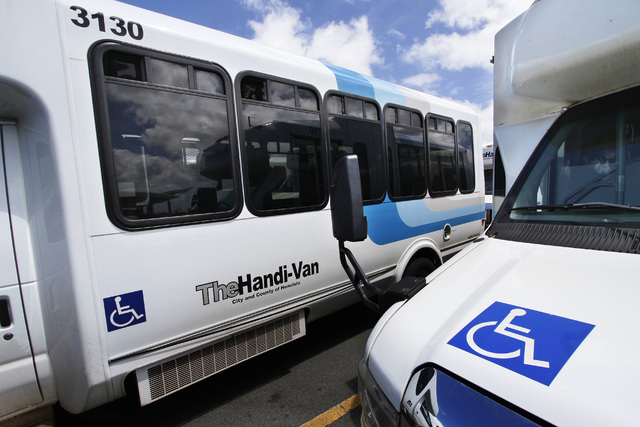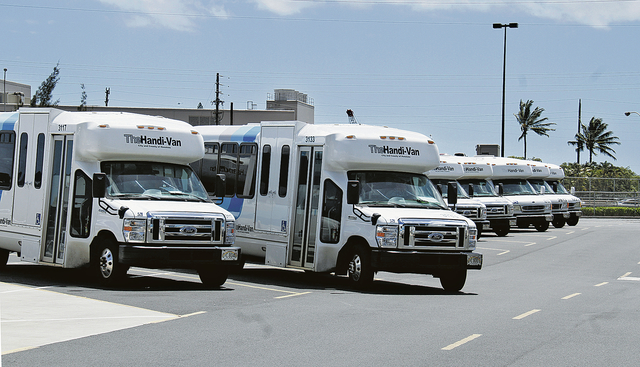A much-anticipated report from the city Auditor’s Office echoes what many riders have voiced for several years: Honolulu’s Handi-Van service has steadily been getting worse in key ways despite efforts to make it better.
On-time arrivals declined by 5 percent in the past three years, dropping to a rate of 81 percent in 2015 from 86.3 percent in 2013, the paratransit audit released Monday found. (“Paratransit” refers to a special transportation service for people with disabilities.)
Additionally, the Handi- Van saw a “significant” number of excessively long trips last year — nearly 24,000 in just nine months — in which the service’s mostly disabled and elderly passengers were stuck on rides that took far longer than they should have, the audit reported.
It further found that the Handi-Van sometimes violated federal Americans with Disabilities Act requirements by favoring “subscription” riders — which generally includes those who use the vans regularly through charitable service agencies — at the expense of others seeking a one-time ride.
Handi-Van, one of the most heavily used paratransit fleets in the nation per capita, provides roughly 3,500 rides across the island each day. It’s operated by Oahu Transit Services, which also runs TheBus. The City Council in 2014 passed a resolution, introduced by then-Councilman Breene Harimoto, requesting an audit of the Handi-Van after fielding numerous user complaints.
The service represents the “most-challenging operation within our transit system, and we acknowledge the areas that need to be improved,” Mike Formby, the city Department of Transportation Services director, said Monday.
The audit recommended raising Handi-Van’s $2 fare for a one-way trip — a price that the report said hasn’t been raised since 2001, and which barely covers the average $40 cost of the subsidized ride. By law the city could raise the fare to as much as $5, and the move would bring fares closer in line with some mainland systems, the report stated.
But such an increase would hit hard some of the paratransit service’s most vulnerable users, including those on fixed incomes, said Donald Sakamoto, president of local paratransit advocacy group Citizens for a Fair ADA Ride.
“Those people on the mainland, they don’t pay as many taxes as we do,” Sakamoto said Monday. In Hawaii, “they’re taxing us for everything.”
Transit officials don’t have plans to raise the fare, and the City Council would have to consider any such idea first, Formby said. Furthermore, any talk of changing Handi-Van fares would have to take place in the broader discussion of how fares for the future rail system, TheBus and Handi-Van will fit together, he added.
The audit looked at the Handi-Van system from fiscal years 2013 through 2015 — a period in which the city added at least 99 new vans, some of which replaced aging, unreliable vehicles that would break down. (In 2011, two Handi-Vans without passengers caught fire due to electrical problems while on the road. In 2014, a quick-thinking Handi-Van driver pulled her two passengers to safety on the side of the road before her van was engulfed in flames.)
During the time covered by the audit, the city also boosted the fleet by 15 percent, to 181 total vehicles from 157, according to the report. “We’ve been buying more vans, we’ve been hiring more people,” Formby said Monday.
“Despite these achievements, managers report OTS capacity is insufficient to support the demand increases and to properly schedule customers when they call to make reservations,” the audit stated. Handi-Van rides often are excessively long when compared with comparable rides on TheBus, it added.
On Oct. 16, it took one passenger 2 hours and 33 minutes to travel 8.7 miles from Waipahu to Kapolei, the audit found. That same day another passenger endured a trip of 2 hours and 8 minutes to make the 15-mile trip from Aiea to Helemano, it further stated.
Transit leaders point to such instances as part of the larger challenge they face when trying to improve Handi-Van service: The island’s grid of roads and highways is rapidly getting more congested.
Even as they make improvements, the crippling traffic from more cars and construction stunts any progress, they say.
“Every driver on Oahu … would say that traffic has gotten much, much worse,” OTS President Roger Morton said Monday. “We’re chasing the solution.”
The audit compared Honolulu with mainland cities such as Portland, Denver and Minneapolis. It also found that the city did not fully implement four of 18 steps in a 2012 “short-range transit operations” plan — and that those unfinished steps could have improved the Handi-Van system. They included a plan to manage the replacement of old vans, getting more customer feedback, and better tracking the number of excessively long trips.
The fourth step, which the audit explored at length, recommended better use of the Handi-Van’s “real-time” computer software to better book reservations. The city implemented that software, called Trapeze, in 2014 with mixed results, officials and passengers say.
Morton said that service agencies such as Easter Seals rely heavily on the Handi-Van to help transport their clients, and that if officials found a way to help those agencies fund their own transport it would help reduce the demand on the Handi-Van and make the service more ADA-compliant.
Those agencies pay the same fares as regular riders even though such agencies pay more in other cities, the audit stated. DTS and OTS “have been working on a plan to obtain higher agency fares through higher federal reimbursements to the State of Hawaii and agencies,” Formby wrote in an email Monday.
KEY FINDINGS OF THE AUDIT
>> The Handi-Van’s successful on-time arrivals fell by 5 percent in the past three years.
>> There were 23,811 excessively long Handi-Van trips recorded during a nine-month period last year.
>> The city replaced aging vans with 99 new ones in 2014 and 2015 but Handi-Van service issues persisted.
>> Transit staff are not fully using their new “real-time” software to schedule van pickups.
>> City officials say worsening traffic on Oahu’s congested streets and highways is making the problem worse, but acknowledge they can still do better.
Handi-Van audit
Correction: The Arc in Hawaii once heavily relied on Handi-Van service but now runs its own transportation program, which is city subsidized and less expensive. It no longer uses Handi-Van. This story initially listed Arc as an agency that still relies on Handi-Van.




